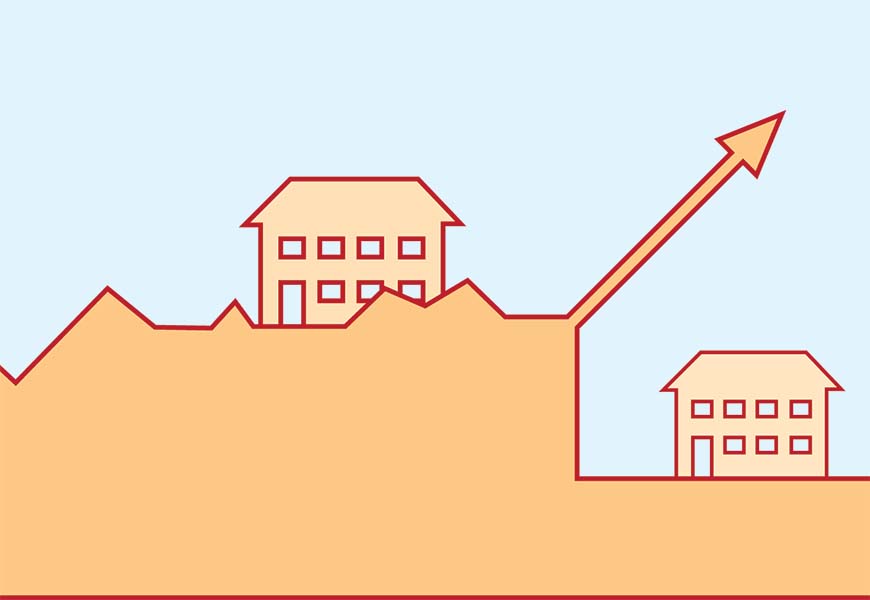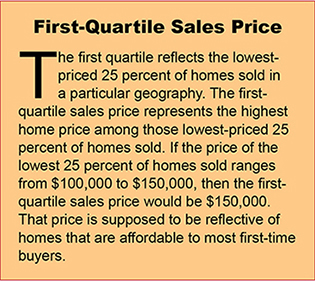
Home Stretch

The recent rise in mortgage interest rates affects potential homebuyers in several ways, including lowering their purchasing power, increasing their mortgage payments, and diminishing their anticipated returns on homeownership. Buyers currently entering the market will take longer to reap the wealth-building benefits of owning a home. |
Homeownership represents the single largest investment—and source of wealth—for most U.S. households, but a multitude of factors have made attaining homeownership more challenging, especially for first-time buyers. The most recent factor is rising mortgage interest rates. In the first half of 2022, the average rate on a 30-year fixed mortgage increased 2 percentage points, from 3.22 percent to 5.7 percent.
Rising interest rates have several implications for potential buyers. To begin with, they diminish buyers’ purchasing power. As mortgage rates go up, so does the mortgage payment, increasing the income necessary to qualify for a mortgage loan. In other words, for the same-priced home, the required income to qualify for a mortgage loan increases as the mortgage rate increases. In effect, this pushes more potential buyers out of the housing market. An estimated 34.8 percent of Texas renters could afford the first-quartile home price in 2Q2022 with a 3 percent interest rate. That proportion declines to 24.7 percent with a 6 percent rate. 
Second, all else being equal, a higher interest rate means a higher mortgage payment, which increases the buyer’s debt-to-income (DTI) ratio. This generally makes a buyer a bigger credit risk to lenders, potentially diminishing the likelihood of qualifying for a mortgage loan. Moreover, a higher DTI ratio can make mortgage repayment more difficult, particularly for borrowers who lose their jobs.
Because higher interest rates result in higher mortgage payments, they diminish the returns on homeownership, prolonging the amount of time necessary to break even on the costs of homeownership.
Impact on Mortgage Payments
Mortgage principal represents the portion of the mortgage payment that goes toward paying off the initial loan amount.
If a buyer makes a 5 percent down payment on a $250,000 home (so, a $12,500 down payment), the loan amount is $237,500. The total amount of mortgage principal to be paid
over the life of the loan (generally 30 years) does not depend on the mortgage interest rate—it always equals the loan amount (in this case, $237,500).
However, the total amount of mortgage principal paid
in any given
year of the loan does depend on the mortgage interest rate. Mortgage principal initially makes up a smaller proportion of the mortgage payment than the mortgage interest does, but over the loan’s duration, the proportion devoted to principal increases while the proportion for interest decreases (Table 1).

Meanwhile, the amount paid in mortgage interest depends on the interest rate obtained by the borrower. For instance, a borrower with a 3 percent rate would pay $7,556 in mortgage interest in year five of homeownership. Meanwhile, a borrower with a 6 percent rate would pay $14,574 that same year. Spending a higher proportion of the mortgage payment on interest—which happens as the rate increases—diminishes the returns on homeownership and prolongs the time necessary to break even on homeownership costs.
How Interest Rates Affect Homeownership Rate of Return
The Texas Real Estate Research Center recently looked at how different interest rates can affect the rate of return on homeownership for first-time buyers. The study’s model made several assumptions (Table 2).
- The home costs $250,000, which was the first-quartile sales price for first-time buyers for an existing single-family home in Texas in 2Q2022.
- The buyer made a 5 percent down payment ($12,500) on a $250,000 home.
- Rent reflected the first-quartile rent for an existing single-family home in Texas in 2Q2022—$1,800 per month, or $21,600 annually. Rent reflects the opportunity cost incurred by the homeowner in purchasing a home. In other words, by purchasing a home, the homeowner is saving on rent. However, the true opportunity cost of homeownership is renting and investing the difference between the mortgage payment and rent in an investment account. For more on that, read “Purchasing a Home Versus Renting and Investing."
- As the loan-to-value ratio exceeds 80 percent (in other words, if there’s less than a 20 percent down payment), the model assumes private mortgage insurance of 0.5 percent.
- The loan term was 30 years.
- Property taxes were 3 percent of the home price; insurance, 1 percent.
- Maintenance costs were 2 percent of the home price.
- Closing costs equated to 2 percent of the purchase price; selling fees were 6 percent.

These assumptions carry several limitations. First, should home price appreciation measure higher (lower) on average than 4 percent, the returns on homeownership will increase (decrease). Second, if closing costs or selling fees measure lower (higher) than 6 percent, the returns on homeownership will increase (decrease). Third, should property taxes, insurance, and maintenance make up less than (more than) a combined 6 percent of home price, the returns on homeownership will increase (decrease). Last, if the down payment increases (decreases), the returns on homeownership will increase (decrease).
Unsurprisingly, the results show a stark difference in the returns on homeownership by mortgage interest rate (Table 3).

First-time buyers with a mortgage rate of 3 percent could expect to break even on their investment after just one year of owning their home, compared with four years for a buyer with a 6 percent rate. As the mortgage rate rises, buyers must hold onto their homes longer to reap the wealth-building benefits of homeownership.
Higher mortgage rates translate into higher cash outflows (mortgage principal and interest plus property taxes, insurance, and maintenance) and lower proceeds from sale (the sales price minus selling expenses and the remaining mortgage balance).
For example, with a rate of 3 percent, homeowners can expect to expend $27,421 in year five on mortgage principal and interest and property taxes, insurance, and maintenance (Table 4). That amount increases to $32,637 with a 6 percent rate.

Meanwhile, homeowners with a rate of 3 percent can expect to make $72,883 from the sale of the home in year five, but only $63,587 with a 6 percent rate.
In addition, higher mortgage rates leave higher residual mortgage balances, because it takes longer for the mortgage principal to be paid down.
____________________
Dr. Losey ([email protected]) is an assistant research economist with the Texas Real Estate Research Center at Texas A&M University.

You might also like

Publications
Receive our economic and housing reports and newsletters for free.





